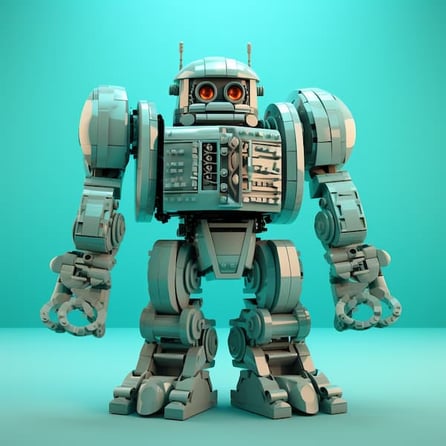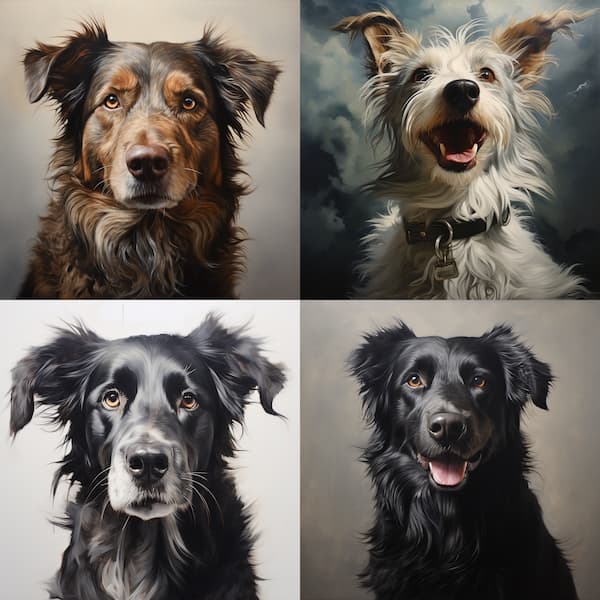Basic principles & examples
Detailled guide: Prompt-Engineering
Everything you need to know to get more fun and efficiency out of
generative AI
Prompt engineering might sound a little complicated at first, but that doesn’t have to be the case. On the contrary: in this guide on prompt engineering, we’ll show you why AI prompting is as easy as building with Lego. And why your tinkering around is almost guaranteed to lead to faster, better work (while having fun at the same time)!
You’ll receive plenty of tips and tricks on how to get more out of the AI tools you already use with prompt adjustments as well as specific prompts that you can either simply copy or use as building blocks for your own prompts. We will frequently be using two “generative artificial intelligence” tools (i.e. AI that generates new content or data) for this, which are very widespread and advanced: ChatGPT (text-to-text) and Midjourney (text-to-image). However, the principles behind these, as well as most of the prompts, also apply to almost all generative AI tools that you need for your everyday marketing.
THE GUIDE CONSISTS OF 3 PARTS:
Content
1. What is prompt engineering – and where do you begin?
Definition of prompt engineering
Why prompt engineering is like playing with Lego
Details vs. no details (practical examples)
Did you know? What are LLMs and text-to-image?
2. How to make your prompts better: 7 building blocks!
7 building blocks you can build with
Target orientation, clarity and context (practical examples)
Length, language and style (practical examples)
ChatGPT/LLM styles and authors that you can use
Midjourney/image-to-text styles to try out
3. Follow-up prompts – How to refine your results iteratively in the AI dialogue
Summary
The best follow-up methods for ChatGPT & co.

Summary: Prompt engineering is the process by which we learn how to best formulate our instructions or “prompts” in order to get the most helpful answers from our AI. A prompt engineer’s job is therefore to create better prompts (instructions).
The general principle here is: the better the prompts, the better the results.
Prompt engineering is thus the art of formulating your instructions in such a way that artificial intelligence understands what you expect from it. This helps us get the best out of the tools.
The principle behind prompt engineering is actually quite simple. We, humans, are the “puppet masters”. The more skilfully we control the “puppets”, the more beautifully they dance for us.
But why should you concern yourself with this? The short answer is that you don’t have to. The generative AI tools that have been becoming increasingly sophisticated since at least spring 2023 often deliver astounding fluke answers, which already enable you to achieve a great deal. But as long as you aren’t refining your prompts in a targeted way, they will most likely remain a fluke.
Why prompt engineering is like playing with Lego
Playing without instructions is always allowed! You can see the difference. Prompt engineering is a bit like playing with a new Lego set. Imagine you have a brand new Lego set in front of you. You could simply start building and see what happens. Perhaps an interesting piece of art will be created; perhaps not. That is a bit like using artificial intelligence (AI) without specific instructions. You could be lucky and get something useful out of it, but it’s just as likely that you’ll get something that doesn’t really meet your needs.
You can see the difference. Prompt engineering is a bit like playing with a new Lego set. Imagine you have a brand new Lego set in front of you. You could simply start building and see what happens. Perhaps an interesting piece of art will be created; perhaps not. That is a bit like using artificial intelligence (AI) without specific instructions. You could be lucky and get something useful out of it, but it’s just as likely that you’ll get something that doesn’t really meet your needs.
It can be fun to simply enter prompts on a whim, and the results can be unexpected, surprising and (unintentionally) funny. It’s even a good method of brainstorming, generating new ideas, and exploring without any limitations. The crucial point is that two important factors are lacking: control and predictability. As you never know what will come out when you use imprecise prompts, it’s not a bad way to get started for surprise effects, creativity and brainstorming.
With instructions, it works just like the picture on the box – even if you’re not a programmer But if there’s one thing that is important for efficiency, fast working and productivity, it’s: control. Predictability. To get good results out of the tools quickly and reliably, you have to be sure that you’ll get what you want as precisely as possible.
But if there’s one thing that is important for efficiency, fast working and productivity, it’s: control. Predictability. To get good results out of the tools quickly and reliably, you have to be sure that you’ll get what you want as precisely as possible.
If you want to use Midjourney, ChatGPT or other AI tools for more than just a bit of fun, then you’re going to need a system in place at some point. Let’s return to the Lego comparison: prompt engineering begins when you take the instructions out of the box.
So, imagine that you’re now following the instructions supplied with the Lego set. You know exactly which parts you need, where they go and in what order you need to assemble them. The result is a specific model, just like the one shown on the box.
Sometimes, you might need several attempts to get it just the way you want. But, as we’ve said, you still notice the difference immediately!
Using AI with a well-constructed prompt is the same. You give the tool precise instructions on what you expect from it, and the result is much more likely to be what you imagined. This is also the idea behind prompt engineering in a nutshell. You can get much more out of the same building blocks with a systematic approach and “instructions”. Sometimes much more than you could actually imagine!
The beauty of this, by the way, is that you don’t have to be a programmer. Just like you don’t have to be a product designer to build Lego models. You “only” have to be able to follow the instructions. And, in the case of prompt engineering, this often means copying good prompts from other sources and adapting a few parts so that they correspond to your goals. There’s no need to reinvent the wheel every time – it’s available to you if you know where to look for it.
In the world of a prompt engineer, technical knowledge and programming languages are no longer so important. Instead, it’s increasingly “meta-knowledge” that matters. You need to know that “instructions” exist, how to use them, how to find and adapt them and, above all, what – very precisely and in maximum detail – you want to achieve with them.
But that’s not all: you can create your own “building plans” Prompt engineers may use existing instructions or building plans, but their main task is to create their own “building plans” (prompts). Which are perfectly adapted to very specific goals. Let’s return to the Lego set: prompt engineers are the ones who create the instructions in the first place. Depending on what the prompt has to be able to do and for which AI tool it is created, it can be very simple or highly technical and time-consuming.
Prompt engineers may use existing instructions or building plans, but their main task is to create their own “building plans” (prompts). Which are perfectly adapted to very specific goals. Let’s return to the Lego set: prompt engineers are the ones who create the instructions in the first place. Depending on what the prompt has to be able to do and for which AI tool it is created, it can be very simple or highly technical and time-consuming.
If you see the powerful robot on the Lego box but prefer to have an almost human Lego butler, you can take your time to create a building plan for that. The result may be a butler that can work for you immediately, and knows & understands your company precisely. You can even ask him questions about your own brand voice, your CI and your personas if you’ve “programmed” him that way. Like a new assistant who you need to train first.
It’s in your hands. You consider what you want to build, plan it carefully and choose the right building blocks. That is what advanced prompt engineering is like. What do you expect from AI? Formulate your prompt so that it meets these expectations. The result is a tailored model (or a tailored response) that precisely meets your needs and expectations.
Creating your own instructions and building according to them is what creating tailored prompts is like. Although this requires more effort and expert knowledge from the start, it enables specific, individually coordinated results to be created and thus ultimately saves a great deal of time. By the way, you don’t need to be an engineer to do this. We’ll show you here how easy it is to get started!
What exactly is a prompt? A prompt is another word for the command or instruction that you give to the AI tool. Prompts are also the cornerstone of interaction with generative AI tools. They are the instructions that we give the AI to control them and achieve the desired results.
A prompt can be pretty much anything: a question, a statement, a request or even a dialogue. It is the input that enables the artificial intelligence to generate a certain output. With a well-formulated prompt, you can have the AI write a blog entry, answer a complex question, generate a creative idea, carry out a data analysis and much more.
One important aspect here is the language. It’s the reason why you don’t have to be a developer to master prompt engineering. The ability to formulate prompts in natural language is what makes interacting with AI tools so accessible and intuitive. In contrast to traditional programming languages, which require special syntax and rules, you can communicate with prompts in your own language. This makes working with AI tools not only easier but also more efficient.
Using prompts as a “programming language” also has another advantage: it enables us to control our “robots” in a way that corresponds to how we naturally think and communicate. Instead of us adapting to the language of the machine, the machine adapts to our language. This means that we can use AI in a way that is intuitive and natural for us. Viewed in this way, this new “programming language” is also a big step towards democratising AI, as it opens up a brand new world full of possibilities to all of us.
-
What is natural language processing (NLP)?
Not all types of artificial intelligence understand our everyday language. The programmes that use natural language are called “natural language processing” (NLP) programmes. They are made to understand, interpret, create and respond to our language.
-
What are large language models (LLMs)?
Experts in language...
What are known as “large language models” are another important type of AI tool that uses natural language. These models, such as ChatGPT from OpenAI or Google’s Bard, are trained to understand and generate human language at a very deep level.
They can be used for a variety of tasks. From answering questions and writing articles to translating texts. (By their very nature, they are not ideal for understanding feelings in human conversations or precisely imitating human gut instinct.)
...not mathematics
It’s important to know: large language models (LLMs) such as ChatGPT are experts in language, not mathematics. They are trained to understand and create texts, not solve complex calculations.
Although they are powerful, they are not made for specific mathematical challenges. There are other tools that are better suited to such tasks. To put it briefly, LLMs are impressive when working with words, but you should use specialised tools for complex numbers. -
What are text-to-image tools?
Generate images with words
Image generation tools such as Midjourney, Leonardo AI or Stable Diffusion generate visual content instead of text. They can create practically any type of image that you can imagine: from works of art and landscapes, film scenes, patterns and backgrounds to mood boards, comics, portraits and more.
That is why they are known as text-to-image tools and do not fall within the LLM category, although you also communicate with them in natural (English) language.
A new world!
With text-to-image tools, we have a world that people have long dreamed of: a world in which words quite literally become images! For some of the providers, the technology is now so advanced that you can barely tell the generated photos from real ones.
The potential of random art
However, what comes out in the end can sometimes differ from what you expected. While LLMs pay attention to every letter in your prompt, tools such as Midjourney sometimes march to a different tune and overlook parts of it.
However, this also offers a huge advantage. It is precisely this unpredictability that can lead to creative strokes of genius that you would never have expected! A new form of “intentional random art” has developed.
Professionelle Übersetzungen
Wir übersetzen für alle Fachbereiche.
So where should you start if you want to get more out of ChatGPT, Midjourney & co. with prompt engineering? The best tip for getting started: pack a lot of details into your prompt! Details can make a huge difference. It’s purely a matter of practising mentioning all relevant details. It’s worth including absolutely anything that’s relevant in the prompt.
Few details: “Write a text about shampoo”
More details: “Write a text for a landing page. For our new organic shampoo, which was specially developed for dry hair. It contains aloe vera and coconut oil, does not contain parabens or sulphates, and the packaging is environmentally friendly.”
It’s not difficult to see why the second text could come much closer to my goal of drawing inspiration for a new text. With Midjourney, we can visualise the difference:
Few details: "A dog"

More details: "A large, joyful Golden Retriever playing in a sunny park, with fluffy fur that shines in the light"

Although none of the images is bad, the Retriever images are much more specific. Most tools work in such a way that they almost can’t help but take the prompts very literally. This means: if you ask for a dog, you get a dog. And not a certain breed, park and sunshine. Or, to put it better, the breed, park and sunshine could have been included – but it would have been a pure fluke. You get what you ask for – and mostly only what you ask for.
Things are similar with ChatGPT. Without details, ChatGPT’s standard answers are rather … standard.
What makes a good prompt (but is not essential)? Almost all good prompts are clear and targeted. They say precisely what you want, are not too long and use simple, understandable language. You can control the answer with keywords and styles. Experiment with different formulations and adapt them based on the results. Always take into account what the model can and can’t do.
So, if you get a disappointing answer from ChatGPT, it may be because ChatGPT doesn’t know what a good answer would be for you. However, that’s something you can tell the AI! And the more explicitly and clearly you do that, the greater the likelihood is that the ultimate result will also be right. For the same reason, there are only a few prompts that can be simply copied and used by everyone. All of us have to first consider precisely and specifically what the ideal result should look like and for what purposes it should be used before we even begin with our robot conversations.
So, if you know precisely what you expect from the interaction with the AI and what details are important, you can get started. But how do we turn theory into practice? Here are seven building blocks, sorted according to their impact on the result, that can help you create better prompts.
Good prompts only fulfil as many factors as it takes to achieve your goals. They are not a checklist where you need to tick off all of the points. On the contrary: less is often more. Too many instructions at once can cause the really important points to get lost in too much text.
| 7 building blocks for better prompts | |
|---|---|
| Target orientation | A good prompt should have a clear goal. It should be specific enough to achieve the desired result, but not so specific that it limits the creativity or flexibility of the model. Tell the tool what you expect from it. |
| Clarity and precision | The formulation of your prompt should be clear and precise. Unclear or ambiguous prompts can lead to unwanted or unexpected results. |
| Context | The instruction should provide the necessary context. This can include information about the desired type of answer, the background to the topic or specific requirements on the answer. All of the details that are important to you should thus be mentioned. |
| Length | The length of the prompt can have an influence on the quality of the answer. Prompts that are too short can lead to general or imprecise answers, while prompts that are too long can overwhelm the model. However, this depends on the tool being used. Or, in other words: the prompt should not be longer than necessary. |
| Language and style | The prompt should be formulated in a language and a style that correspond to the model and the desired result. This can include the use of technical jargon, formal or informal language or specific styles. |
| Adaptability | The best prompts are often also adaptable and can be adapted or refined on the basis of the answer that you receive. Adaptability means that you can use them as your own building blocks. |
| Use of keywords | Using keywords can help to achieve the desired results. These keywords can specify styles, highlight topics or control specific aspects of the desired answer. You can also help guide the AI towards certain ways of thinking or perspectives, which leads to more creative and more relevant answers. |
7 Bausteine für bessere Prompts
- Zielorientierung
Ein guter Prompt sollte ein klares Ziel haben. Er sollte spezifisch genug sein, um das gewünschte Ergebnis zu erzielen, aber nicht so spezifisch, dass es die Kreativität oder Flexibilität des Modells einschränkt. Teile dem Tool mit, was du von ihm erwartest. - Klarheit und Präzision
Die Formulierung deines Prompts sollte klar und präzise sein. Unklare oder mehrdeutige Prompts können zu unerwünschten oder unerwarteten Ergebnissen führen. - Kontext
Die Anweisung sollte den notwendigen Kontext liefern. Dies kann Informationen über die gewünschte Art der Antwort, den Hintergrund des Themas oder spezifische Anforderungen an die Antwort beinhalten. Es sollten also alle Details erwähnt werden, die dir wichtig sind. - Länge
Die Länge des Prompts kann einen Einfluss auf die Qualität der Antwort haben. Zu kurze Prompts können zu allgemeinen oder ungenauen Antworten führen, während zu lange Prompts das Modell überfordern können. Das ist jedoch Tool-abhängig. Oder anders ausgedrückt: Der Prompt sollte nicht länger als notwendig sein. - Sprache und Stil
Der Prompt sollte in einer Sprache und einem Stil formuliert sein, die dem Modell und dem gewünschten Ergebnis entsprechen. Dies kann die Verwendung von Fachjargon, formeller oder informeller Sprache oder spezifischen Stilrichtungen beinhalten. - Anpassungsfähigkeit
Oft sind die besten Prompts auch anpassungsfähig und bieten die Möglichkeit, auf Basis der erhaltenen Antwort angepasst oder verfeinert zu werden. Anpassungsfähig heißt, dass du sie als deine eigenen Bausteine nutzen kannst. - Verwendung von Schlüsselwörtern
Die Verwendung von Schlüsselwörtern kann dazu beitragen, die gewünschten Ergebnisse zu erzielen. Diese Schlüsselwörter können Stile festlegen, Themen hervorheben oder spezifische Aspekte der gewünschten Antwort lenken. Sie können auch dazu beitragen, die KI auf bestimmte Denkweisen oder Perspektiven zu lenken, was zu kreativeren und relevanteren Antworten führt.
Let’s now take a look at a few practical examples. Bear in mind: the best way to become an expert at this is to get hands-on and experiment with it! Anything is possible!
Target orientation, clarity and context (practical examples)
Examples of prompts relating to marketing that you can enter directly into ChatGPT – with adaptations, of course – can be found below. What they have in common is that they formulate clearly what the end result should look like and give the chatbot a great deal of context so that the answer can also be specific and not general.
ChatGPT examples
Competition analysis (possible with ChatGPT Plus)
“Visit our main competitor’s website at www.competitor-website.com. Analyse the main features of their products and services and create a list of five points in which we could improve to become more competitive.”
Content ideas
“I am the content manager for a company that manufactures fitness equipment. We would like to fill our blog with useful and appealing content for fitness enthusiasts. Optimised for SEO. Suggest four blog topics that focus on the benefits of our products and general fitness tips.”
Email marketing campaign
“Here is the current text for our email marketing campaign: (enter your email here) Adapt the text so that it is more personal and more appealing. Our goal is to increase the click rate and encourage customers to buy our new products. Our target group is (describe your target group)”
SEO-optimised blog post
“Here is the beginning of our new blog post: (Insert text) Could you please continue this blog post and include the keywords ‘sustainable design’, ‘innovative technology’ and ‘high quality’? Our goal is to create an informative and SEO-optimised blog post, which would encourage our website visitors to find out more about our new product.”
Midjourney examples
 Very detailed goal:
Very detailed goal:
“Highly realistic portrait of an older woman in a forest setting, kind, weathered face full of wisdom and character, with deep laugh lines and sparkling eyes full of life,her hair is a mix of silver and white, loosely tied back, with a few strands escaping around her face, she's wearing a warm, earth-toned sweater and a pendant necklace. She's standing amidst tall, ancient trees, their leaves a mix of vibrant and fading colors, indicating the onset of autumn. The dappled sunlight filters through the canopy, casting a soft, warm glow on her face. In her hand, she holds a walking stick, her expression is one of peace and contentment, as if she's in her favorite place in the world“
What is an advantage for ChatGPT – context with breadth and depth – is too much for Midjourney. Although the result above is of higher quality, many details have not made it from the text into the image. (For example, the sweater, necklace and walking stick described in the prompt.)
What’s more, although the image is “highly realistic”, it is not a photograph. It is thus also an example that shows you often get quite literally what you ask for. A photograph was not requested, so a highly realistic painting is just as likely a result as a photograph. The tool simply has to guess what you want.
So, it is not a matter of providing as many details as possible, but – especially with Midjourney – really only providing the really important, crucial points. Let’s say that we really need a photograph and a sweater, walking stick and necklace absolutely have to be included. Then we naturally include the word “photography”, which is important for our goal, and remove the parts of the prompt that are unnecessary:
 Detailed, clear goal:
Detailed, clear goal:
“Realistic portrait of an older woman in a forest setting holding a walking stick, kind, weathered face full of wisdom and character, with deep laugh lines and sparkling eyes, hair, silver and white, warm earth-toned sweater, pendant necklace, sunlight, warm glow, autumn, photography“
We are now not only asking for a picture of an older woman in a forest, but have placed “holding a walking stick” much more prominently. We were thus able to adapt the result to our priorities.
Both of the “woman in the forest” pictures also illustrate why the length of the instructions can make a big difference. This is “learning by doing” – some programmes will be able to fulfil your goal better if the inputs are very long and detailed, others tend to swallow half of them. There are some very long prompts in the collection of our marketing prompts. We have had positive experiences with these when using ChatGPT. However, for Midjourney, we recommend you try to keep things shorter!
Midjourney tip: To generate an image in Midjourney, you enter /imagine, followed by your prompt. However, you can also enter /shorten. If you then enter your prompt, you get back four shortened versions, which only list the words (or “tokens”) that the tool considers important. You can then have the images generated straight away.
One of the tokens (words in the prompt) that every AI model is sure to prioritise highly is language information. No matter what you enter into ChatGPT, you always also state in what language and in what style your answer should be. Either explicitly because you ask for it in the prompt, or implicitly because the programme otherwise adapts automatically to your language!
ChatGPT examples: Using any kind of jargon with role-playing
The language that you use in your prompt is like a roadmap for ChatGPT. It helps the AI model understand in what style and tone it should answer. And it can adapt to almost any language style you can imagine! If you write in English, it will answer in English, and so on. But it also takes things a step further.
If, for example, you want an answer in marketing jargon, you can formulate your prompt with corresponding specialist terms and phrases. Or if you want to talk in the language of a civil engineer, use technical terms and specific expressions from this field. ChatGPT will pick up on this information and adapt the answer accordingly.
Here are a few examples of how you can use that in a targeted way with the prompt engineering technique “role-playing”:
ChatGPT as a marketing expert (or civil engineer, or...)
“Explain to me, as if you were a marketing expert, how to carry out a successful social media campaign.” Or “Describe the process of constructing a high-rise building as if you were a civil engineer.”
Create performance optimisation instructions
“Give me detailed instructions on how to measure and optimise the performance of an online advertising campaign, as if you were a marketing controller.”
Create an Instagram post
“Draft an appealing post for Instagram which highlights the advantages of our latest (software update), as if you were a social media manager.” (Supplemented with the necessary context information, of course)
Gain inspiration for an inbound marketing strategy
“As an experienced content marketing specialist, create a comprehensive guide on implementing an inbound marketing strategy, which contains both the theory and practical application examples.” (Supplemented with the necessary context information, of course)
ChatGPT examples: How to get any tone and style you want
But that’s just the tip of the iceberg. With an LLM, you can go even deeper and further adapt the tone and style of your answer. You can, for instance, ask for an answer in a humorous or sarcastic tone, or ask ChatGPT to write a story in the style of a certain author or a certain era. The possibilities really are endless!
A small selection of examples:
Sarcastic marketing expert
“As a sarcastic marketing expert, explain to me why traditional advertising methods are still relevant in the digital era.”
In the style of Jane Austen
“Tell a romantic story in the style of Jane Austen about two AI programmes that fall in love with each other.”
Investigative journalism
“Write an article in the style of an investigative journalist about the effects of AI on the workplace.” (This input could be supplemented wonderfully with a link reader plugin, which allows you to have ChatGPT investigate for you online. There are a range of plugins available with ChatGPT Plus.)
Beatnik style
“Write a short story in the style of beatnik literature about a journey through the Internet.”
Like a travel blogger
“Write a blog post in the style of a travel blogger about the ‘journey’ through various programming languages.”
-
40 language style examples for ChatGPT & co.
- Humorous
- Sarcastic
- Ironic
- Romantic
- Investigative
- Adventurous
- Scientific
- Philosophical
- Lyrical
- Epic
- Dramatic
- Tragic
- Comedic
- Satirical
- Mystical
- Imaginative
- Realistic
- Surrealistic
- Horror
- Thriller
- Detective story
- Western
- Science Fiction
- Fantasy
- Magical
- Young Adult
- Children’s book
- Dystopian
- Utopian
- Steampunk
- Cyberpunk
- Gothic
- Noir
- Postmodern
- Expressionistic
- Impressionistic
- Futuristic
- Minimalist
- Baroque
- Rococo
-
40 authors whose style you can try out
In this list, you will find classic and modern best-selling authors as a source of inspiration. They could offer you new approaches for how to formulate your content.
To try out an author style in ChatGPT, you only have to ask for it in the prompt, for example: “Write the introduction to a blog post on the subject of XY in the style of (author).”
- William Shakespeare: Poetic and dramatic; ideal for advertising that emphasises elegance and classicism.
- Jane Austen: Astute and elegant; perfect for targeted campaigns.
- Charles Dickens: Detailed and socially critical; good for social campaigns.
- Mark Twain: Humorous and sarcastic; ideal for humorous advertising campaigns.
- F. Scott Fitzgerald: Lyrical and descriptive; suitable for luxurious brands.
- Ernest Hemingway: Clear and direct; ideal for clear and concise messages.
- Leo Tolstoy: Epic and philosophical; for profound and contemplative campaigns.
- George Orwell: Critical and dystopian; for educational and political advertising.
- Agatha Christie: Exciting and enigmatic; for mysterious and exciting campaigns.
- Virginia Woolf: Flowing and introspective; for introspective and emotional advertising.
- James Joyce: Complex and modernistic; for intellectual and avant-garde campaigns.
- Herman Melville: Profound and allegorical; for epic and adventurous advertising.
- Oscar Wilde: Witty and satirical; ideal for creative and humorous campaigns.
- Emily Dickinson: Lyrical and introspective; for emotional and poetic advertising.
- Franz Kafka: Surreal and allegorical; for profound and reflective campaigns.
- Fyodor Dostoevsky: Psychological and profound; for introspective and philosophical advertising.
- John Steinbeck: Realistic and socially critical; for social and cultural campaigns.
- H.G. Wells: Futuristic and speculative; for innovative and visionary advertising.
- Edgar Allan Poe: Dark and mysterious; for exciting and scary campaigns.
- Brontë sisters: Romantic and dramatic; for emotional and passionate advertising.
- J.K. Rowling: Magical and imaginative; ideal for family-friendly campaigns.
- Stephen King: Suspenseful and creepy; for horror or suspense campaigns.
- George R.R. Martin: Complex and detailed; for epic and large-scale advertising campaigns.
- Paula Hawkins: Suspenseful and psychological; for mysterious and profound campaigns.
- E.L. James: Sensual and controversial; for daring and provocative campaigns.
- Dan Brown: Puzzling and historical; for cultural and mysterious advertising.
- Khaled Hosseini: Emotional and cultural; for emotional and cultural campaigns.
- Chimamanda Ngozi Adichie: Cultural and feminist; for educational and female-oriented campaigns.
- Yuval Noah Harari: Analytical and historical; for intellectual and educational advertising.
- Malcolm Gladwell: Insightful and analytical; for educational and thought campaigns.
- Neil Gaiman: Imaginative and mythical; for creative and magical advertising.
- Margaret Atwood: Dystopian and critical; for educational and visionary campaigns.
- Jodi Picoult: Emotional and current; for emotional and social campaigns.
- Haruki Murakami: Surreal and lyrical; for creative and dream-like advertising.
- Isabel Allende: Magically realistic and cultural; for cultural and magical advertising.
- John Green: Youthful and emotional; for youth-oriented and emotional campaigns.
- Nicholas Sparks: Romantic and heart-breaking; for emotional and romantic advertising.
- Zadie Smith: Contemporary and cultural; for modern and cultural campaigns.
- Toni Morrison: Profound and cultural; for reflective and cultural advertising.
- Salman Rushdie: Complex and allegorical; for intellectual and cultural campaigns.
Midjourney examples: The style determines everything
And the same applies to Midjourney. Here, too, you can influence the style of your image with your prompt. For example, you can ask for an image in an impressionistic style, or have Midjourney create an image that is reminiscent of the works of a certain artist. You can even ask for an image in a certain colour scheme or with a certain mood. Like with ChatGPT, the possibilities are only limited by your imagination!
The difference can be seen from a mile away. Here is the result of the same prompt in which only a single word has been replaced:











Creativity now does not begin during the creation of the image but long before that. When thinking up and trying out the motifs, styles and language. Depending on what you want to achieve with your instructions, prompt engineering, more than anything else, is an incredibly creative activity. Its biggest challenges include the need to imagine everything and combine new words and styles with each other.
In working with generative computer programmes, editing and selecting are also important elements in this creative work. Which of the four (or 100?) generated images should be used and why? Which of the ChatGPT-created formulations can be adopted and why? We humans still have to invest the “brainpower”, but the cognitive energy is shifting and is particularly important in pre- and post-production.
Midjourney tip: Midjourney offers you a simple platform to discover creative ideas and implement them yourself. After logging in, you can see the latest images from the community at https://www.midjourney.com/app/feed/. There, you can also look for certain motifs or keywords to seek inspiration. If you find an image in a style that you want to try out, simply click on the image and you can then see the prompt. This way, you can also create your own images based on the original. A simple way to build on existing ideas.
Below you can find many other styles and artist names with which you can let your creativity run wild using Midjourney (or Stable Diffusion, Dall-E or another text-to-image generator of your choice).
-
50 styles for Midjourney & co.
If you would like to use a style in your text-to-image tool, simply insert the English word for your desired style into your prompt, such as “impressionist painting of...” or “(XY), impressionism”.
-
- Impressionism: Characterised by loose brush strokes and the depiction of light and atmosphere.
- Expressionism: Emphasises subjective emotions and reactions through distorted and exaggerated representations.
- Surrealism: Depicts dream landscapes and unexpected combinations of objects.
- Abstract expressionism: Focuses on spontaneous, emotional expressions and large, abstract brush strokes.
- Pop art: Uses images from pop culture and mass media, often in bright colours.
- Futurism: Emphasises speed, technology and the modern urban experience.
- Dadaism: An anti-artistic style characterised by nonsense and randomness.
- Fauvism: Uses wild, bright colours and simplified shapes.
- Art Deco: A stylised, geometric style, which was popular in the 1920s and 1930s.
- Post-impressionism: A response to impressionism, characterised by a greater emphasis on shape and colour.
- Neo-impressionism: Uses small, dot-shaped brush strokes to emphasise light and colour.
- Symbolism: Emphasises emotional and mystical themes through symbolic images.
- Photorealism: Represents objects in an extremely realistic level of detail.
- Neo-impressionism: A return to expressive, figurative paintings in the 1980s.
- Constructivism: A geometric, abstract style that focuses on the ideas of the Russian Revolution.
- Suprematism: An abstract style characterised by simple geometric shapes.
- Bauhaus: A modernistic style characterised by functionality and simplicity.
- Op art: Uses optical illusions and contrasting colours to suggest movement.
- Hard-edge painting: An abstract style characterised by clear, sharp edges and colour blocks.
- Colour field: Emphasises large areas in a single colour.
- Tachisme: An abstract style characterised by spontaneous brush strokes.
- Lyrical abstraction: An emotional, intuitive style characterised by flowing shapes.
- Conceptual art: Emphasises ideas about the physical representation of art.
- Street art/graffiti: Art created on streets and in public places.
- Psychedelic art: Uses bright colours and swirling patterns to create a “trip” effect.
- Lowbrow art: A pop surrealist style characterised by cartoon-like images.
- Pixel art: Art made up of small pixels, similar to old video games.
- Vaporwave aesthetics: A retro style characterised by pastel colours and 1980s themes.
- Cyberpunk style: Emphasises high-tech worlds and dystopian future scenarios.
- Steampunk style: Combines a Victorian aesthetic with futuristic technologies.
- Gothic style: A medieval style characterised by pointed arches and detailed stonework.
- Baroque style: An opulent style characterised by curved shapes and rich details.
- Byzantine style: A medieval style characterised by golden mosaics and rounded arches.
- Mannerism: A style characterised by exaggerated proportions and complex compositions.
- Pre-Raphaelite: A style characterised by detailed, realistic representations of nature and figures.
- Neoclassicism: A style characterised by clear lines and classic themes from antiquity.
- Precisionism: A style characterised by clear, precise representations of industrial and urban landscapes.
- Glitch art: Art created by digital errors and distortions.
- Hyperrealism: An extremely realistic style that often imitates photographs.
- Kawaii art: A sweet, childish style that comes from Japan.
- Zine culture aesthetics: A DIY style characterised by handmade magazines and collages.
- Seapunk aesthetics: A retro style characterised by mermaids, dolphins and 90s Internet graphics.
- Brutalist web design: A minimalist, raw web design style.
- Bio art: Art that uses living organisms and biological processes.
- Generative art: Art created by algorithms and computer programmes.
- Data moshing: A digital art medium characterised by the manipulation of video data.
- ASCII art: Art made up of text characters.
- Vaporwave: A music and art style characterised by nostalgic 1980s and 1990s themes.
- Net art: Art created and presented on the Internet.
- Post-Internet art: Art that investigates the effects of the Internet on society.
-
-
50 visual artists whose style you can try out
To try out the visual style of an artist, you can either simply add the name to the prompt in Midjourney (or in the text-to-image generator of your choice) or write “in the style of...” before it.
For example: “photograph of the North Sea, Ansel Adams” or “photograph of the mountains, in the photographic style of Ansel Adams”.
- Ansel Adams – Early 20th century: Impressive black and white landscape photographs, particularly of Yosemite National Park.
- Cindy Sherman – Late 20th century: Conceptual self-portraits that explore different female stereotypes.
- Stanley Kubrick – 20th century: Film director with symmetrical image composition and profound themes.
- Wes Anderson – Modern: Films with pronounced sense of symmetry, pastel colours and headstrong characters.
- Salvador Dalí – 20th century: Surrealist paintings with melting clocks and dream-like landscapes.
- Diane Arbus – Mid 20th century: Intimate portraits of people at the fringes of society.
- Akira Kurosawa – 20th century: Japanese films with epic stories and dynamic fight scenes.
- Frida Kahlo – Early 20th century: Self-portraits that express pain and passion.
- Gregory Crewdson – Modern: Large-format photographs that depict cinematic scenes in the suburbs.
- Quentin Tarantino – Modern: Films with non-linear narratives, sharp dialogue and stylised violence.
- Yayoi Kusama – Modern: Installations and paintings with infinite dotted patterns.
- Henri Cartier-Bresson – 20th century: Street photography that captures the “key moment”.
- David Lynch – Modern: Films and TV shows with surreal, dream-like sequences.
- Banksy – Modern: Street art with political and social commentary.
- Vivian Maier – Mid 20th century: Street photography that captures daily life in Chicago and New York.
- Pedro Almodóvar – Modern: Spanish films with vivid colours and complex female characters.
- Georgia O'Keeffe – 20th century: Large-format floral pictures and desert landscapes.
- Andrei Tarkovsky – 20th century: Films with long shots, reflections about memories and spirituality.
- Robert Mapplethorpe – Late 20th century: Photographs depicting the human body and flowers in high-contrast light.
- Jean-Michel Basquiat – Late 20th century: Graffiti-inspired painting with bold colours and symbols.
- Christopher Nolan – Modern: Films with complex narrative structures and profound philosophical themes.
- Marina Abramović – Modern: Performance art that tests the limits of the body and mind.
- Helmut Newton – 20th century: Fashion photography with strong, often provocative female images.
- Ai Weiwei – Modern: Installations and sculptures that address political themes and human rights.
- Sofia Coppola – Modern: Films with a sensual style that often emphasise the isolation of the characters.
- Andy Warhol – 20th century: Pop art images of celebrities and everyday objects.
- Terrence Malick – Modern: Films with meditative images of nature and reflections on life.
- Dorothea Lange – 20th century: Photographs that show the effects of the Great Depression in the USA.
- Damien Hirst – Modern: Concept art, often with animals in formaldehyde or colourful spot paintings.
- Wong Kar-wai – Modern: Hong Kong films with melancholic love stories and impressive colour palettes.
- Richard Avedon – 20th century: Portrait photography that captures the essence of his subjects.
- James Turrell – Modern: Light installations that change the space and the perception of the viewer.
- Lars von Trier – Modern: Films with controversial themes and often shocking images.
- Barbara Kruger – Modern: Graphic design and photography with sharp social commentary.
- Martin Scorsese – Modern: Films that often investigate organised crime and complex characters.
- Tracey Emin – Modern: Concept art that often addresses personal experiences and emotions.
- Edward Hopper – Early 20th century: Paintings of lonely figures in urban environments.
- Alfred Hitchcock – 20th century: Thrillers and horror films with suspense and iconic images.
- Jeff Wall – Modern: Large-format photographs that often show everyday scenes in a new light.
- Jean-Luc Godard – 20th century: French New Wave films with innovative narrative techniques.
- Annie Leibovitz – Modern: Portrait photography with celebrities, often in elaborate settings.
- David Hockney – Modern: Colourful paintings of swimming pools and Californian landscapes.
- Federico Fellini – 20th century: Italian films with surreal images and characters.
- Bill Viola – Modern: Video installations that investigate human experiences and emotions.
- Joel Meyerowitz – Modern: Street and landscape photography in vibrant colours.
- Yasujirō Ozu – 20th century: Japanese films that investigate family relationships in quiet shots.
- Jenny Holzer – Modern: Text-based art that often uses provocative messages or truisms.
- Sergio Leone – 20th century: Western films with epic landscapes and iconic characters.
- Shirin Neshat – Modern: Photography and video that concerns itself with gender roles in the Middle East.
- Robert Frank – 20th century: Photography that shows life in post-war America in a raw, unembellished style.
Summary: The first prompt rarely does the job. As good as it may be, the actual magic of chat-based AI tools lies in the fact that feedback and a dialogue are possible. The principle of follow-up prompts works in very different ways depending on whether you are working with an LLM such as ChatGPT or a text-to-image generator such as Midjourney.
What all of the tools have in common, however, is that they really only fulfil their true potential when you go beyond the first answer and use follow-up prompts. This allows you to deepen and analyse the answers and better understand them.
What is a follow-up prompt? A follow-up prompt is an additional question or instruction that you enter after you have already received an initial answer from the AI. Or, to put it another way: it’s nothing more than an answer to the answer.
The best follow-up methods for ChatGPT & co.
With LLMs such as ChatGPT, the possibilities of follow-up prompts are particularly diverse. You’ve probably experienced this: you spend what feels like a whole afternoon chatting with ChatGPT but the history still isn’t visible after many minutes of scrolling. In contrast to many other applications, large language models have the huge advantage that you can quite literally talk to them. This also means that we can say precisely what was good and what missed the mark. This allows us to hone the result that we have in mind. Like with prompt engineering itself, there are almost infinite ways to refine answers in dialogue with the tool. You could pretty much train your AI like a new personal employee.
However, here are four very simple methods of taking follow-up prompting in the right direction:
|
Analysis prompts Dhese allow you to assess and analyse (generated) content or suggestions. Examples: Evaluation: Once ChatGPT has presented us with a palette of marketing strategies, we can dig deeper: “What are the strengths and weaknesses of the first three strategies?” |
|
Feedback prompts We use these to get an assessment of a certain suggestion or an idea. This allows you to evaluate any text that you have written or had generated. The AI can thus offer feedback to itself or to you. Examples: CTAs: “How effective do you assess the call-to-action in this newsletter and why?” SEO: “Which of the suggested keywords has the greatest potential of pushing our website higher in the search results and why?” Website design: “How user-friendly is the suggested design compared to current web standards and why?” Content: When considering publishing a new blog post: “How do you assess the relevance of the topic for our readership and what aspects could be particularly appealing?” Text generation: If you have had ChatGPT or a similar tool generate a text that you are not happy with: “Rewrite, this time simpler and more understandably. Avoid repetitions and clichés.” |
|
Expansion prompts With expansion prompts, you can deepen or vary the original answers from your LLM. This gives you more possible selections or more detailed information about a topic. Examples: Other suggestions: “10 further ideas that all differ” or “15 further suggestions in different styles” or “generate 20 headings, sorted by likelihood of being received well by the target group XY” Get more out of the suggestions: --- Original request: “I am planning an advertising campaign for our new fitness drink. Which main topic do you suggest?” |
|
Comprehension prompts These prompts help us to translate complex or technical information into simpler, easy-to-understand terms. They are particularly useful if you want to ensure that a wider audience or team members without specific expert knowledge can understand the content. Examples: “Imagine you are explaining it to someone who has never heard of (XY). How would you describe it?” “Understanding prompt: “Could you explain that with an example from everyday life so that it is easier to understand?” “Please explain that as if you were describing it to a beginner” “Could you explain the concept of conversion rate optimisation with an example from a physical shop?” “If SEO was like organising a book shop with the most popular books being the easiest to find, how would you then describe it?” |





